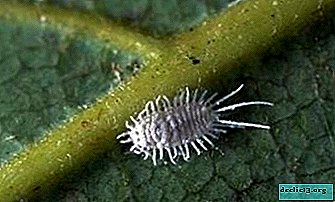Elegant garden decoration - Oriental Express rose: photos, description and cultivation secrets

Rose - popular in decorating squares, parks and garden plots. Rose of the Orient Express variety looks very elegant, refined.
In our article, we will examine in more detail the variety of roses - Orient Express, you will see how such flowers look, how they differ from other varieties, how to properly care for them.
You will also learn what are the ways of propagating such a rose, how to do it correctly.
Grade description
Rosa Orient Express - tea - hybrid species. The flowers are creamy yellow, with raspberry fringing, with a light fruity aroma. The foliage is dark and shiny. The bush reaches a height of 120 - 150 cm, and a width of 2 meters. It blooms profusely from June to September.
Grade Advantages:
- The bush is resistant to disease, frost and heat.
- Long, plentiful flowering.
Grade Cons:
- Flowers bloom quickly, because of this you have to constantly cut wilted buds so that they do not spoil the overall appearance.
- This kind of roses will not take root in your home. For growth and budding, he needs open ground.
Photo
Further on the photo you can see what the Orient Express rose variety looks like.





History of occurrence
This rose variety was bred in 2001 by American breeders Jerry Twomey and Ping Lim. Its basis was a rose of the Gloria Day variety of yellow - pink color. Rose won high awards at prestigious competitions, among them - the title of "Golden Rose" of the rose contest in Baden - Baden in 2003.
What is the difference from the rest of the species?
The Orient Express rose variety is different from the types of roses in that it combines several bright, pleasing colors in one flower at once. It has a light, unobtrusive aroma, which is an important plus. Having planted only this variety on your site, you can no longer think about purchasing roses of a different kind.
Bloom
When does it blossom and how does it happen?
It blooms profusely, without interruption, from June to September. Dense flowers with a bright color. The diameter, when it opens, reaches 14 cm.
Features of care before and after flowering
Look after the Orient Express rose before and after flowering. She needs frequent, shallow cultivation, top dressing, mulching, not frequent, but plentiful watering. Watering: 2 times a week, with especially dry weather - 3 times. When watering, water should reach the depth of the very bottom of the roots.
They feed it with manure or special complex fertilizers. During flowering, you need to constantly prune buds that have faded or have just begun to wilt.
What to do if it does not blossom?
 The reasons why the rose does not bloom and their elimination:
The reasons why the rose does not bloom and their elimination:
- Wrong landing place. Roses do not like the lack of sunlight. For full development, they need coverage of at least 8 hours a day.
- Incorrect pruning. In spring, Orient Express roses cannot be pruned heavily. It is possible to carry out a sanitary and light shaping haircut.
- Improper care. If your rose has a weakened, oppressed bush with fallen leaves - you need to feed it.
- Bacterial burn. A rose affected by a bacterial burn will never bloom. He appears under cover after wintering. In the spring, the bushes are inspected, and if there is damage, cut out. Otherwise, it can infect the rest of the bush.
- Aging. Old roses cease to bloom. Age more than 3 years - it is time to rejuvenate them. Every year, spring shoots that are over 3 years old are cut out in the spring.
Use in landscape design
Rosa Orient Express will be perfectly combined with flowers of less saturated shades. It will look good also among perennial non-flowering plants (for example, a host).
Step-by-step care instructions
Seat selection
The rays of the sun should fall on a rose all daylight. Air should flow freely into the bush, but drafts are undesirable.
Timing
A rose can be planted both in spring and autumn. What should be the soil. A good soil composition for roses is chernozem and loam, enriched with nutrients. Groundwater level should not be higher than 1 meter. Soil acidity is low.
Landing
Seeds
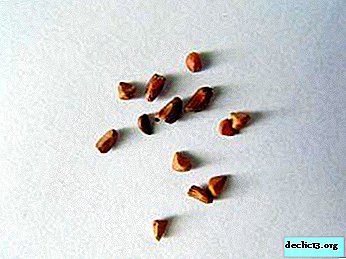 How to choose the right seeds of roses. Seeds are better to buy in specialized stores. Be sure to familiarize yourself with the information given on the bag with seeds. Check expiration date.
How to choose the right seeds of roses. Seeds are better to buy in specialized stores. Be sure to familiarize yourself with the information given on the bag with seeds. Check expiration date.- Seed preparation. First of all, you need to stratify the seeds. After stress, the seeds hatch quickly when they enter the nutrient soil. This procedure lasts 20 days. After it, the seeds are soaked for 6 hours in 3% hydrogen peroxide or in Epin.
- Preparation of soil and tanks for planting. Preparation of containers consists in washing with hot water with the addition of soda. Dry the containers before using. They must have drainage holes. For soil, mix one part of the turf soil, humus and sifted river sand. To disinfect, you need to calcine it in the oven for 3 to 4 hours or spill it with a solution of dark potassium permanganate. Or buy special soil in a store that does not need to be processed.
- Sowing roses seeds. A simple way is to sow rose seeds in the snow. First, the tank is filled with soil, compacted, no need to be watered. 5 cm thick snow is laid on top of it. Lay out the seeds in the snow. The container is closed with foil with holes. The snow will melt, moistening the seeds. Do not water until emergence. When the earth dries up, watered dropwise, with a pipette or from a spray bottle.
- Seedling Care. After the emergence of shoots, you can’t immediately remove the shelter. It is removed every day, for a short time, increasing the airing time. A pick is done when the seedlings turn 60 days old. A few weeks before planting in open ground, seedlings are taken to fresh air, from 30 to 60 minutes, every day, adding half an hour.
Seedlings
- How to choose the right seedlings. When buying seedlings, you need to inspect the stems and roots for damage, traces of decay, mold, dried areas. They must have healthy, strong leaves. The stem must have at least 2 - 3 branches.
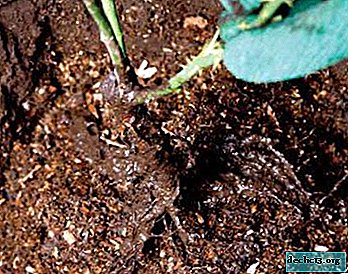 Landing. The plot for the seedling is dug to a depth of 40 - 50 centimeters. When digging, humus and sand are added to the soil to increase the air permeability of the soil.
Landing. The plot for the seedling is dug to a depth of 40 - 50 centimeters. When digging, humus and sand are added to the soil to increase the air permeability of the soil.They dig a hole, 60 cm deep. And lay drainage on the bottom. A thin layer of soil is poured on top. Nitrofosku can be added and mixed with the ground. To reduce acidity - add a handful of ash. In the center of the pit, make a mound of land 10-15 cm high. A sapling is planted on the mound so that the grafted place is 4-5 centimeters lower than the surface level. The roots spread across the mound. After planting, the soil around the seedling is well crushed and watered. The surface is mulched.
Soak the rose seedlings before planting in a solution of Heterouxin or Kornevin, to activate the processes of root growth and their simultaneous disinfection.
Temperature
For the growth of roses, Orient Express has the best air temperature of 15 - 22 degrees. Soil temperature - 17 degrees, but not higher than 20 Watering. Young plants need regular watering. Need to water 2 to 3 times a week.
Roses are watered only with warm, settled water.
Top dressing
Fresh manure (especially horse manure) is well suited as a dressing for roses. You can use the fertilizer purchased in the store, phosphorus - potash. Feed when the bushes release buds. The second time it is done in the fall, after flowering, while hilling bushes. Then in the spring all the necessary useful components will come to the roots of the plant.
note. In stores you can buy many special fertilizers for roses, for different stages of plant development, which combines all the necessary substances.Weeding
Rose bushes should not be allowed to overgrow with weeds; trunks should be weeded regularly.
Pruning
- Preventative. Do early spring and late fall. Weak, deformed, broken, dying shoots, as well as with signs of disease or pest damage, are removed. They are cut off at the very base of the stem.
- Formative. Pruning starts from the moment of planting and is periodically repeated throughout the life of the rose. Cut the shoots to an open bud so that the young twig grows out.
Transfer
You can transplant roses in spring and autumn. The plant should grow stronger in a new place before frost or heat.
It is not recommended to transplant blooming roses.
Preparation for winter
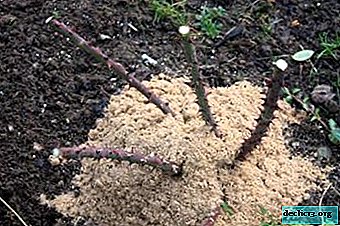 With the advent of autumn, stop watering the plant.
With the advent of autumn, stop watering the plant.- At the end of September, cut off all dried leaves.
- The bushes should be treated with a disinfecting solution from pathogens (copper sulfate, etc.).
- With cold weather, mandatory hilling of the bush so that the roots of the plants do not freeze.
- At the end of September, spend gentle trimming, leaving a margin of shoot length in case of freezing.
- Cover the bushes by making a mini-greenhouse or hut made of lapnik.
Breeding
The varietal characteristics of Oriental Express roses can be preserved only by vegetative propagation methods.
Dividing the bush
Propagation of roses by dividing the bush is carried out in autumn or early spring before the buds have opened.
- The secateurs cut 2/3 of the branches. Do it in the evening. At the same time, it is good to water.
- Dig the roots of the rose the next day in the evening.
- Secateurs divide the roots of the bush into parts so that there are enough roots and 2 to 3 buds on it.
- Separated bushes planted in the ground, like an ordinary seedling.
Cuttings
- Cut the cuttings with secateurs or clippers and root in moist soil. Plant cuttings on a bed - at an angle of 45 degrees, they are abundantly moistened with water several times a day.
- Top with a film or glass to preserve moisture.
- Leave rooted cuttings for the winter under shelter, and in the spring plant in separate landing pits.
Diseases and Pests
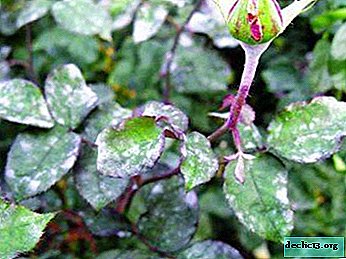 Powdery mildew. Fungal disease. The leaves are deformed, a whitish coating forms on them. Treat the plant with a special compound - Forecast or Topaz. For prevention, spraying is done in March. Wood ash - also helps to avoid the defeat of the rose powdery mildew. It is sprinkled with soil around a rose bush.
Powdery mildew. Fungal disease. The leaves are deformed, a whitish coating forms on them. Treat the plant with a special compound - Forecast or Topaz. For prevention, spraying is done in March. Wood ash - also helps to avoid the defeat of the rose powdery mildew. It is sprinkled with soil around a rose bush.- Rust. It appears in the form of brown or orange spots on the leaves. Reason: high humidity. Control measures - Ridomill - Gold or Profit formulations; for prevention, the rose is processed at the end of May.
- Brown fungus. Appears on bushes and leaves, and then on the flower itself. An effective remedy is Fundazole.
- Infectious burns. They come in the form of reddish-brown spots. Appear in the winter, under cover. In spring, all damaged areas should be cut off.
- Chlorosis. Leaves fade and fade. The reason is a lack of nutrition or the fact that the roots have lost the ability to fully absorb fertilizers, due to the high humidity of the soil. To treat a rose, spray it, twice with a period of 14 days, with an iron-containing solution.
The most common pests are:
- Aphid. He stains the leaves in the form of sticky slurry, sucks out all the juices from the leaves. May creep into flowers. Fufanon, Aktara, and Actellik help well.
- Leaflet. The type of butterflies that inhabit the flower with small caterpillars of black - green color. Leaves dry and curl. It is necessary to cut off all diseased leaves and burn, and treat the bush itself with Karbofos or Entobacterin.
In this article, you learned how to grow an Orient Express rose. Caring for her is not difficult and anyone, even a beginner gardener, can handle it. She just needs attention and care so that she will delight you all summer with her beautiful flowering.

 How to choose the right seeds of roses. Seeds are better to buy in specialized stores. Be sure to familiarize yourself with the information given on the bag with seeds. Check expiration date.
How to choose the right seeds of roses. Seeds are better to buy in specialized stores. Be sure to familiarize yourself with the information given on the bag with seeds. Check expiration date. Landing. The plot for the seedling is dug to a depth of 40 - 50 centimeters. When digging, humus and sand are added to the soil to increase the air permeability of the soil.
Landing. The plot for the seedling is dug to a depth of 40 - 50 centimeters. When digging, humus and sand are added to the soil to increase the air permeability of the soil. With the advent of autumn, stop watering the plant.
With the advent of autumn, stop watering the plant. Powdery mildew. Fungal disease. The leaves are deformed, a whitish coating forms on them. Treat the plant with a special compound - Forecast or Topaz. For prevention, spraying is done in March. Wood ash - also helps to avoid the defeat of the rose powdery mildew. It is sprinkled with soil around a rose bush.
Powdery mildew. Fungal disease. The leaves are deformed, a whitish coating forms on them. Treat the plant with a special compound - Forecast or Topaz. For prevention, spraying is done in March. Wood ash - also helps to avoid the defeat of the rose powdery mildew. It is sprinkled with soil around a rose bush.















